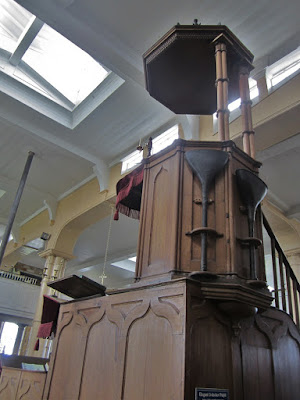'Now perhaps the most depraved sacred building in the kingdom,' said Rev W Keane.
I think it's fascinating. All those pews - so many they blocked the view of the chancel for most of the congregation, hence Keane's comment.
I wonder what went on in those pews, out of sight (for the most part) of all but those within.
Graffiti ...
There's no artificial lighting in the church ...
... apart from that provided by candles ...
... and this stove is the only source of heat. You'd be forgiven, surely, for cuddling up a bit to keep warm.
Ancient - 15th century? - stone font, found in a field serving as trough
Ancient - 15th century? - iron-bound parish chest
The triple-decker pulpit
Anglo-Saxon coffin for a baby
A window honouring Cædmon, the earliest English poet whose name is known. An Anglo-Saxon, he cared for the animals during the abbacy of St Hild (1614-680). According to St Bede, he was ignorant of 'the art of song' but learnt to compose one night during a dream. Only one of his poems has survived.
Here's a cross set up in the churchyard in his honour in 1898.
And yes, that churchyard, famously falling into the sea and showering the ground below the cliff below with bones.
Some seriously weathered headstones here.
I am not so sure I would like to go there at night:
'There was a
bright full moon, with heavy black, driving clouds, which threw the whole scene
into a fleeting diorama of light and shade as they sailed across. For a moment
or two I could see nothing, as the shadow of a cloud obscured St. Mary's Church
and all around it. Then as the cloud passed I could see the ruins of the abbey
coming into view, and as the edge of a narrow band of light as sharp as a
sword-cut moved along, the church and churchyard became gradually visible. Whatever my
expectation was, it was not disappointed, for there, on our favourite seat, the
silver light of the moon struck a half-reclining figure, snowy white. The
coming of the cloud was too quick for me to see much, for shadow shut down on
light almost immediately, but it seemed to me as though something dark stood
behind the seat where the white figure shone, and bent over it. What it was,
whether man or beast, I could not tell.'
from 'Dracula' by Bram Stoker




















Lucky you! One place I would love to visit :)
ReplyDeleteDefinitely worth the journey!
DeleteSounds so dreamy.
ReplyDeleteGoing to have to reread 'Dracula' now, I think. Such a great novel.
DeleteThank you so much for this
ReplyDeleteThank you for reading, Martin x
Delete